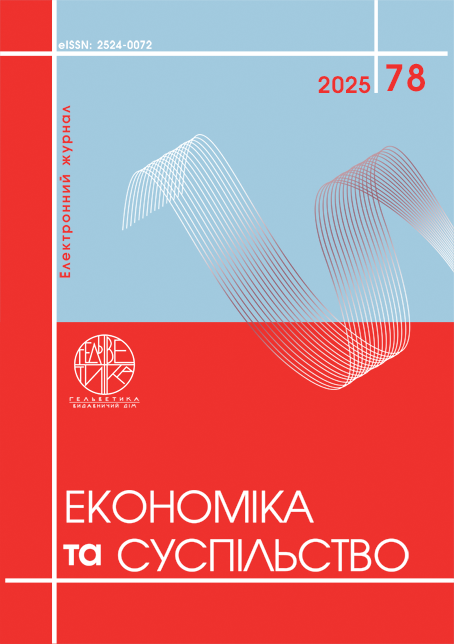METHODOLOGY FOR OPTIMIZING THE STRUCTURE OF UKRAINE’S PUBLIC DEBT UNDER CONDITIONS OF FINANCIAL TURBULENCE
Abstract
The article proposes a methodology for optimizing Ukraine's public debt structure in conditions of financial turbulence. It justifies the transition from narrowly focused approaches to an integrated methodology that simultaneously takes into account four key parameters of debt sustainability: the share of annual debt payments in budget revenues (fiscal acceptability); the ratio of external to internal debt (structural balance of funding sources); currency composition of the portfolio (minimum acceptable share of liabilities in national currency); uniformity of the maturity profile (no excessive repayment peaks in any year of the horizon). The methodology is presented as a sequential decision-making algorithm: inventory of the portfolio by source, currency, maturity, and type of rate; diagnosis of deviations from specified thresholds; corrective actions with a fixed priority sequence (first, reduction of the payment burden, then smoothing of maturity peaks, then increasing the hryvnia share and equalizing the share of external debt); recalculation of indicators and minimum stress testing of the suitability of decisions to basic shocks in rates, exchange rates, and income (as an element of the methodology). The proposed algorithm can be used as a tool for regular (quarterly) review of debt strategy and is consistent with the requirements of program-budget management. The relevance of this approach is determined by the need to simultaneously control the budgetary burden, currency vulnerability, the timing of payments, and dependence on external creditors in conditions of limited domestic market capacity and uneven financial revenues. The application of the methodology leads to the formation of a coordinated target portfolio structure across four dimensions (source, currency, maturity, type of rate), a balanced medium-term payment schedule, a quarterly calendar of operations, and a clear protocol for monitoring indicators, which increases the predictability of debt policy. The practical value lies in the transparency of the rules and the reproducibility of the procedures: the methodology does not require complex models, is based on available aggregate indicators, is easily integrated into the budget cycle, and ensures regular updates of the target debt structure, taking into account operational and legal constraints.
References
Барановський О. І. Дослідження теоретичних засад боргової безпеки держави. Науковий вісник Ужгородського університету. Серія «Економіка». 2016. № 1(47)(1). С. 327–337.
Богдан Т. П. Боргова безпека та її роль у гарантуванні фінансової стабільності. Вісник Національного банку України. 2012. № 4. С. 8–15.
Clements, B. External debt, public investment, and growth in low-income countries. Washington, D.C.: International Monetary Fund, 2003.
Cochrane, J. H. Long-term debt and optimal policy in the fiscal theory of the price level. Econometrica, 2001, 69(1), pp. 69–116. DOI: https://doi.org/10.1111/1468-0262.00179
Dosi, G., Fagiolo, G., Napoletano, M., Roventini, A., & Treibich, T. Fiscal and monetary policies in complex evolving economies. Journal of Economic Dynamics and Control, 2015, 52, pp. 166–189. DOI: https://doi.org/10.1016/j.jedc.2014.11.014
Ященко Л. О. Прогнозування державного боргу на основі доходів та видатків державного бюджету України. Статистика України. 2014. № 2. С. 14–19. URL: http://nbuv.gov.ua/UJRN/su_2014_2_4
Ієфименко Т. І., Єрохіна С. А., Богдан Т. П. Боргова стійкість державних фінансів. Київ : ДННУ «Акад. фін. управління», 2014. 712 с. ISBN 978-966-2380-80-4.
International Monetary Fund, & International Development Association. Debt sustainability – Proposal for an operational framework and policy implications. Washington, D.C., 2004. URL: http://www.imf.org/external/np/pdr/sustain/2004/020304.htm
Карапетян О., Рибак С. Боргова стійкість України: критерії оцінювання та особливості методології. Вісник Тернопільського національного економічного університету. 2011. № 3. С. 49–57.
Ministry of Finance of Ukraine. Statistical materials on the state-guaranteed debt of Ukraine. URL: https://www.mof.gov.ua/uk/borgova-politika
Pienkowski, A. Debt limits and the structure of public debt. Journal of Globalization and Development, 2017, 8(2). DOI: https://doi.org/10.1515/jgd-2017-0016
Reinhart, C. M., & Rogoff, K. S. This time is different: Eight centuries of financial folly. Princeton: Princeton University Press, 2009.
Reinhart, C. M., & Rogoff, K. S. Growth in a time of debt. NBER Working Paper, 2010, No. 15639. National Bureau of Economic Research.
World Bank. International debt statistics. Washington, D.C., n.d. URL: http://data.worldbank.org/data-catalog/international-debt-statistics
Zhuravka, F., Filatova, H., Šuleř, P., & Wołowiec, T. State debt assessment and forecasting: Time series analysis. Investment Management and Financial Innovations, 2021, 18(1), pp. 65–75. DOI: https://doi.org/10.21511/imfi.18(1).2021.06
Baranovskyi, O. I. (2016). Doslidzhennia teoretychnykh zasad borhovoi bezpeky derzhavy. Naukovyi visnyk Uzhhorodskoho universytetu. Seriia Ekonomika, 1(47)(1), 327–337.
Bohdan, T. P. (2012). Borhova bezpeka ta yii rol u harantuvanni finansovoi stabilnosti. Visnyk Natsionalnoho banku Ukrainy, 4, 8–15.
Clements, B. (2003). External debt, public investment, and growth in low-income countries. International Monetary Fund.
Cochrane, J. H. (2001). Long-term debt and optimal policy in the fiscal theory of the price level. Econometrica, 69(1), 69–116. DOI: https://doi.org/10.1111/1468-0262.00179
Dosi, G., Fagiolo, G., Napoletano, M., Roventini, A., & Treibich, T. (2015). Fiscal and monetary policies in complex evolving economies. Journal of Economic Dynamics and Control, 52, 166–189. DOI: https://doi.org/10.1016/j.jedc.2014.11.014
Iashchenko, L. O. (2014). Prohnozuvannia derzhavnoho borhu na osnovi dokhodiv ta vydatkiv derzhavnoho biudzhetu Ukrainy. Statystyka Ukrainy, 2, 14–19. Available at: http://nbuv.gov.ua/UJRN/su_2014_2_4
Iefymenko, T. I., Yerokhina, S. A., & Bohdan, T. P. (2014). Borhova stiikist derzhavnykh finansiv. Kyiv: DNNU “Akad. fin. upravlinnia”. ISBN 978-966-2380-80-4
International Monetary Fund, & International Development Association. (2004). Debt sustainability – Proposal for an operational framework and policy implications. Available at: http://www.imf.org/external/np/pdr/sustain/2004/020304.htm
Karapetian, O., & Rybak, S. (2011). Borhova stiikist Ukrainy: kryterii otsiniuvannia ta osoblyvosti metodolohii. Visnyk Ternopilskoho natsionalnoho ekonomichnoho universytetu, 3, 49–57.
Ministry of Finance of Ukraine. (n.d.). Statistical materials on the state-guaranteed debt of Ukraine. Available at: https://www.mof.gov.ua/uk/borgova-politika
Pienkowski, A. (2017). Debt limits and the structure of public debt. Journal of Globalization and Development, 8(2). DOI: https://doi.org/10.1515/jgd-2017-0016
Reinhart, C. M., & Rogoff, K. S. (2009). This time is different: Eight centuries of financial folly. Princeton University Press.
Reinhart, C. M., & Rogoff, K. S. (2010). Growth in a time of debt (NBER Working Paper No. 15639). National Bureau of Economic Research.
World Bank. (n.d.). International debt statistics. Available at: http://data.worldbank.org/data-catalog/international-debt-statistics
Zhuravka, F., Filatova, H., Šuleř, P., & Wołowiec, T. (2021). State debt assessment and forecasting: Time series analysis. Investment Management and Financial Innovations, 18(1), 65–75. DOI: https://doi.org/10.21511/imfi.18(1).2021.06
Copyright (c) 2025 Ганна Філатова

This work is licensed under a Creative Commons Attribution 4.0 International License.


